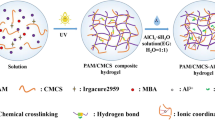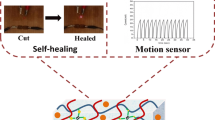Abstract
Given the poor mechanical properties of traditional adhesive hydrogels, many pieces of research have been focused on the preparation of adhesive hydrogels with good mechanical properties and expanded their application. In this study, a novel multifunctional adhesive hydrogel acrylated adenine/chitosan/polyacrylamide/ Fe(III)(Aa/CS/PAM/Fe(III)) hydrogels were prepared by a chemical and physical hybrid crosslinking strategy. The hydrogels can adhere to various solid substrate surfaces and show good mechanical properties. The highest adhesion strength of the hydrogel to wood reached 11.17 kPa with the fracture stress being 0.11 MPa and the toughness 0.84 MJ/m3. The hydrogels can be stretched to more than 1400% of their original length without breaking. Additionally, the hydrogels also have good repetitive adhesion and fatigue resistance. Due to the presence of Fe3+ and Cl−, hydrogels also have certain electrical conductivity, which can be used in human motion detection.











Similar content being viewed by others
References
Hamidi M, Azadi A, Rafiei P (2008) Hydrogel nanoparticles in drug delivery. Adv Drug Delivery Rev 60(15):1638–1649. https://doi.org/10.1016/j.addr.2008.08.002
Bastiancich C, Danhier P, Preat V, Danhier F (2016) Anticancer drug-loaded hydrogels as drug delivery systems for the local treatment of glioblastoma. J Controll Release 243:29–42. https://doi.org/10.1016/j.jconrel.2016.09.034
Hur J, Im K, Kim SW, Kim J, Chung DY, Kim TH, Jo KH, Hahn JH, Bao Z, Hwang S, Park N (2014) Polypyrrole/agarose-based electronically conductive and reversibly restorable hydrogel. ACS Nano 8(10):10066–10076. https://doi.org/10.1021/nn502704g
Huang Y, Zhong M, Shi F, Liu X, Tang Z, Wang Y, Huang Y, Hou H, Xie X, Zhi C (2017) A intrinsically stretchable and compressible supercapacitor containing a polyacrylamide hydrogel electrolyte. Angew Chem Int Ed 56(31):9141–9145. https://doi.org/10.1002/anie.201705212
Wang H, Shi J, Wang Y, Yin Y, Wang C (2014) Promotion of cardiac differentiation of brown adipose derived stem cells by chitosan hydrogel for repair after myocardial infarction. Biomaterials 35(13):3986–3998. https://doi.org/10.1016/j.biomaterials.2014.01.021
Someya T, Bao Z, Malliaras GG (2016) The rise of plastic bioelectronics. Nature 540:379–385. https://doi.org/10.1038/nature21004
Rus D, Tolley MT (2015) Design, fabrication and control of soft robots. Nature 521:467–475. https://doi.org/10.1038/nature14543
Drury JL, Mooney DJ (2003) Hydrogels for tissue engineering: scaffold design variables and applications. Biomaterials 24(24):4337–4351. https://doi.org/10.1016/s0142-9612(03)00340-5
Balakrishnan B, Mohanty M, Umashankar PR, Jayakrishnan A (2005) Evaluation of an in situ forming hydrogel wound dressing based on oxidized alginate and gelatin. Biomaterials 26(32):6335–6342. https://doi.org/10.1016/j.biomaterials.2005.04.012
Choi S, Lee H, Ghaffari R, Hyeon T, Kim DH (2016) Recent advances in flexible and stretchable bio-electronic devices integrated with nanomaterials. Adv Mater 28:4203–4218. https://doi.org/10.1002/adma.201504150
Hoare TR, Kohane DS (2008) Hydrogels in drug delivery: Progress and challenges. Polymer 49(8):1993–2007. https://doi.org/10.1016/j.polymer.2008.01.027
Cui CY, Fan CC, Wu YH, Xiao M, Wu TL, Zhang DF (2019) Water-triggered hyperbranched polymer universal adhesives: From strong underwater adhesion to rapid sealing hemostasis. Adv Mater 31(49):1905761. https://doi.org/10.1002/adma.201905761
Cholewinski A, Yang F, Zhao BX (2019) Algae–mussel-inspired hydrogel composite glue for underwater bonding. Mater Horiz 6(2):285–293. https://doi.org/10.1039/C8MH01421C
Fathalla M, Lawrence CM, Zhang N, Sessler JL, Jayawickramarajah J (2009) Base-pairing mediated non-covalent polymers. Chem Soc Rev 38(6):1608–1620. https://doi.org/10.1039/b806484a
Nakahata M, Takashima Y, Hashidzume A, Harada A (2015) Macroscopic self-assembly based on complementary interactions between nucleobase pairs. Chem Eur J 21(7):2770–2774. https://doi.org/10.1002/chem.201404674
Burkett JR, Hight LM, Kennyand P, Wilker JJ (2010) Oysters produce an organic-inorganic adhesive for intertidal reef construction. J Am Chem Soc 132(36):12531–12533. https://doi.org/10.1021/ja104996y
Courtois BJ, Baroudi I, Nouvel N, Degrandi E, Pensec S, Ducouret G (2010) Supramolecular soft adhesive materials. Adv Funct Mater 20(11):1803–1811. https://doi.org/10.1002/adfm.200901903
Swanson JP, Martinez MR, Cruz MA, Mankoci SG, Costanzob PJ, Joy A (2016) A coacervate-forming biodegradable polyester with elevated LCST based on bis-(2-methoxyethyl) amine. Polym Chem 7(28):4693–4702. https://doi.org/10.1039/C6PY00814C
Herbert Waite J (2017) Mussel adhesion-essential footwork. J Exp Biol 220(4):517–530. https://doi.org/10.1242/jeb.134056
Guo Q, Chen JS, Wang JL, Zeng HB, Yu J (2020) Recent progress in synthesis and application of mussel-inspired adhesives. Nanoscale 12(3):1307–1324. https://doi.org/10.1039/C9NR09780E
Lee H, Scherer NF, Messersmith PB (2006) Single-molecule mechanics of mussel adhesion. Proc Natl Acad Sci USA 103(35):12999–13003. https://doi.org/10.1073/pnas.0605552103
Gallivan JP, Dougherty DA (2000) A computational study of cation-π interactions vs salt bridges in aqueous media: implications for protein engineering. J Am Chem Soc 122(5):870–874. https://doi.org/10.1021/ja991755c
Dougherty DA (2013) The cation–π interaction. Acc Chem Res 46(4):885–893. https://doi.org/10.1021/ar300265y
Ghobril C, Grinstaff MW (2015) The chemistry and engineering of polymeric hydrogel adhesives for wound closure: a tutorial. Chem Soc Rev 44:1820–1835. https://doi.org/10.1039/c4cs00332b
Cui C, Liu W (2021) Recent advances in wet adhesives: adhesion mechanism, design principle and applications. Prog Polym Sci 116:101388. https://doi.org/10.1016/j.progpolymsci.2021.101388
Gong C, Lu C, Li B, Shan M, Wu G (2017) Injectable dopamine-modified poly (α, β-aspartic acid) nanocomposite hydrogel as bioadhesive drug delivery system. J Biomed Mater Res Part A 105(4):1000. https://doi.org/10.1002/jbm.a.35931
Liu Y, Lee BP (2016) Recovery property of double-network hydrogel containing a mussel-inspired adhesive moiety and nano-silicate. J Mater Chem B 4:6534–6540. https://doi.org/10.1039/c6tb01828a
Chen JS, Liu JF, Thundat T, Zeng HB (2019) Polypyrrole-doped conductive supramolecular elastomer with stretchability, rapid self-healing, and adhesive property for flexible electronic sensors. ACS Appl Mater Interfaces 11(20):18720–18729. https://doi.org/10.1021/acsami.9b03346
Luca M, Vittorio O, Cirillo G, Curcio M, Czuban M, Farfalla A, Hampel S, Nicoletta FP, Iemma F (2018) Electro-responsive graphene oxide hydrogels for skin bandages: the outcome of gelatin and trypsin immobilization. Int J Pharm 546(1–2):50–60. https://doi.org/10.1016/j.ijpharm.2018.05.027
Cirillo G, Curcio M, Spizzirri UG, Vittorio O, Tucci P, Picci N, Iemma F, Hampel S, Nicoletta FP (2017) Carbon nanotubes hybrid hydrogels for electrically tunable release of curcumin. Eur Polym J 90:1–12. https://doi.org/10.1016/j.eurpolymj.2017.03.011
Xie C, Li P, Han L, Wang Z, Zhou T, Deng W, Wang K, Lu X (2017) Electroresponsive and cell-affinitive polydopamine/polypyrrole composite microcapsules with a dual-function of on-demand drug delivery and cell stimulation for electrical therapy. NPG Asia Mater 9:e358. https://doi.org/10.1038/am.2017.16
Zhao P, Wei K, Feng Q, Chen H, Wong DSH, Chen X, Wu C, Bian L (2017) Mussel-mimetic hydrogels with defined cross-linkers achieved via controlled catechol dimerization exhibiting tough adhesion for wet biological tissues. Chem Commun 53(88):12000–12003. https://doi.org/10.1039/c7cc07215e
Wang T, Colver PJ, Bon SAF, Keddie JL (2009) Soft polymer and nano-clay supra- colloidal particles in adhesives: synergistic effects on mechanical properties. Soft Matter 5(20):3842–3849. https://doi.org/10.1039/b904740a
Matos-Pérez CR, White JD, Wilker JJ (2012) Polymer composition and substrate in- fluences on the adhesive bonding of a biomimetic, cross-linking polymer. J Am Chem Soc 134(22):9498–9505. https://doi.org/10.1021/ja303369p
Liu X, Zhang Q, Gao G (2017) Bioinspired adhesive hydrogels tackified by nucleobases. Adv Funct Mater 27(44):1703132. https://doi.org/10.1002/adfm.201703132
Bhatia SC, Ravi N (2000) A magnetic study of an Fe-chitosan complex and its relevance to other biomolecules. Biomacromolecules 1(3):413–417. https://doi.org/10.1021/bm0002959
Xu J, Jin R, Duan L, Ren X, Gao G (2019) Tough, adhesive and conductive polysaccharide hydrogels mediated by ferric solution. Carbohydr Polym 211:1–10. https://doi.org/10.1016/j.carbpol.2019.01.091
Tang T (2001) Synthesis and character of new mixed-ligand and complexes of copper (II) with schiff-base. J Inorg Chem 17(5):745–750
Wang YL, Li BQ, Zhou Y, Wang DJ (2009) In situ mineralization of magnetite nanoparticles in chitosan hydrogel. Nanoscale Res Lett 4(9):1041–1046. https://doi.org/10.1007/s11671-009-9355-1
Yang L, Li J, Feng L, Li W, Yang H, Zhang X, Li Y (2016) A Facile preparation of CoFe2O4 nanoparticles on polyaniline-functioned carbon nanotubes as enhanced catalysts for oxygen evolution reaction. J Mater Chem A 4(12):4472–4478. https://doi.org/10.1039/c5ta10420c
Leveneur J, Geoffrey Waterhouse IN, Kennedy J, Metson JB, Mitchel DRG (2011) Nucleation and growth of Fe nanoparticles in SiO2: A TEM, XPS, and Fe L-edge XANES investigation. J Phys Chem C 115(43):20978–20985. https://doi.org/10.1021/jp206357c
Zhang Q, Liu X, Duan L, Gao G (2019) Ultra-stretchable wearable strain sensors based on skin-inspired adhesive, tough and conductive hydrogels. Chem Eng J 365:10–19. https://doi.org/10.1016/j.cej.2019.02.014
Liu X, Zhang Q, Gao Z, Hou R, Gao G (2017) Bioinspired adhesive hydrogel driven by adenine and thymine. ACS Appl Mater Interfaces 9(20):17645–17652. https://doi.org/10.1021/acsami.7b04832
Fan H, Wang J, Zhang Q, Jin Z (2017) Tannic acid-based multifunctional hydrogels with facile adjustable adhesion and cohesion contributed by polyphenol supramolecular chemistry. ACS Omega 2(10):6668–6676. https://doi.org/10.1021/acsomega.7b01067
Zhang Q, Liu X, Ren X, Duan L, Gao G (2018) Adenine-mediated adhesive and tough hydrogel based on hybrid crosslinking. Eur Polym J 106:139–147. https://doi.org/10.1016/j.eurpolymj.2018.07.018
Acknowledgements
This work was supported in part by the National Natural Science Foundation of China (21665024), the Basic Project of Science and Research of Colleges and Universities of Gansu Province (5001-109), and the Project for Young Teacher of Northwest Normal University (NWNU-LKQN-13-6).
Author information
Authors and Affiliations
Corresponding author
Ethics declarations
Conflict of interest
The authors declare that they have no conflict of interest.
Additional information
Publisher's Note
Springer Nature remains neutral with regard to jurisdictional claims in published maps and institutional affiliations.
Supplementary Information
Below is the link to the electronic supplementary material.
Supplementary file2 (MP4 2547 kb)
Rights and permissions
About this article
Cite this article
Ren, J., Li, M., Wang, X. et al. Adhesive hydrogels with toughness, stretchability, and conductivity performances for motion monitoring. Polym. Bull. 80, 1335–1351 (2023). https://doi.org/10.1007/s00289-022-04110-8
Received:
Revised:
Accepted:
Published:
Issue Date:
DOI: https://doi.org/10.1007/s00289-022-04110-8




